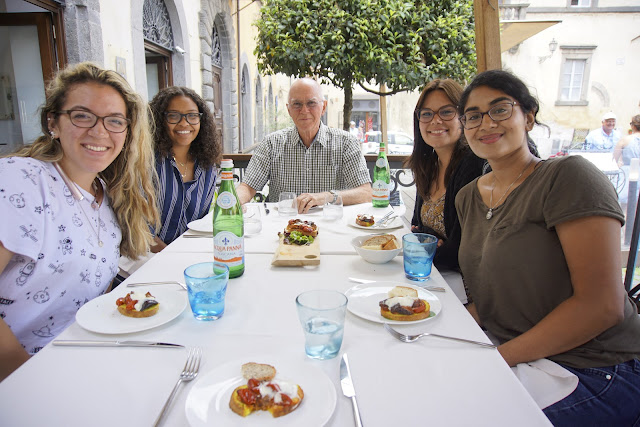I was up early for a walk, then we walked to the UA Study Abroad Program classes by 11. We talked with several students, I took some photos, Claudio gave us travel advice about seeing nearby Etruscan sites, and we invited four UA students for lunch with us in Piazza del Poppolo. We had a stimulating lunch conversation with four bright girls!
After lunch, Papa rested and I walked over to the Duomo. The construction of the cathedral began in 1290, when the first stone was laid by Pope Nicholas IV, and construction lasted almost three centuries. The Gothic facade of the Duomo is considered one of the great masterpieces of the Late Middle Ages. The golden frontage is magnificent, decorated by large bas-reliefs and statues with the symbols of the Angel, Ox, Lion, and Eagle (the Evangelists). The bas-reliefs on the piers depict biblical stories from the Old and New Testaments, and are considered among the most famous of all 14th century sculpture. Above are glittering mosaics representing the life of the Virgin Mary. On the interior, the columns are of alternate rows of travertine and basalt.
The walls of the church are decorated with frescoes painted in the 1300’s-early 1400’s. The chapel walls and ceilings are completely covered in frescoes and very colorful. The windows are made of thin alabaster with stained glass panels above. The Papal Palace attached to the Duomo was begun in the mid 13th century when the popes moved to Orvieto to escape conflict in Rome. Pope Urban IV and Pope Martin IV lived in the town and oversaw construction of the Papal Palace. Pope Boniface VIII extended the building but it was left unfinished following the papal move to Avignon in 1309. It remained a papal residence until 1550, when it was passed to the ownership of the church and is today used as a museum.
After lunch, Papa rested and I walked over to the Duomo. The construction of the cathedral began in 1290, when the first stone was laid by Pope Nicholas IV, and construction lasted almost three centuries. The Gothic facade of the Duomo is considered one of the great masterpieces of the Late Middle Ages. The golden frontage is magnificent, decorated by large bas-reliefs and statues with the symbols of the Angel, Ox, Lion, and Eagle (the Evangelists). The bas-reliefs on the piers depict biblical stories from the Old and New Testaments, and are considered among the most famous of all 14th century sculpture. Above are glittering mosaics representing the life of the Virgin Mary. On the interior, the columns are of alternate rows of travertine and basalt.
The walls of the church are decorated with frescoes painted in the 1300’s-early 1400’s. The chapel walls and ceilings are completely covered in frescoes and very colorful. The windows are made of thin alabaster with stained glass panels above. The Papal Palace attached to the Duomo was begun in the mid 13th century when the popes moved to Orvieto to escape conflict in Rome. Pope Urban IV and Pope Martin IV lived in the town and oversaw construction of the Papal Palace. Pope Boniface VIII extended the building but it was left unfinished following the papal move to Avignon in 1309. It remained a papal residence until 1550, when it was passed to the ownership of the church and is today used as a museum.














